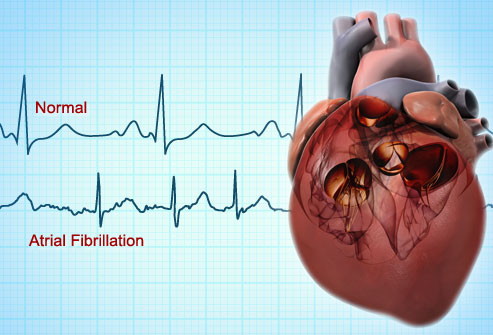

Atrial fibrillation is an irregular and chaotic rhythm (electrical disorder) that comes from the heart’s upper chambers. Normally, the heart’s upper two chambers generate electrical activity at 60-100 times a minute, but in atrial fibrillation patients, the upper chamber beats at 400-500 times per minute.
Luckily, ‘AV node’, the junction between the lower and upper chamber, allows only a few of those signals to reach the lower chamber. Despite this, the lower chambers still can beat as fast as 150-200 times per minute.
Incidents of atrial fibrillation can come and go, but if this health concern develops over time it may require medical attention. Though it is usually not a life-threatening condition, atrial fibrillation is still considered as a serious condition that may require emergency medical attention sometimes.
This condition may lead to complications and can cause the formation of blood clots in the heart that may circulate to other organs in the body. This eventually results in blocked blood flow (ischemia). Atrial fibrillation can be treated with medications along with other interventions to modify the electrical system of the heart.
Doctors have classified Atrial Fibrillation as following:
The most common cause of atrial fibrillation is damage to the structure of the heart or abnormalities in it. Other possible causes of Afib include:
A healthy lifestyle may help reduce the chances of atrial fibrillation. However, not all causes are avoidable. It is very important to inform your medical practitioner about your medical history, so they can treat your condition better.
The faulty electrical signals make the heart beat faster than it should. The abnormal beating stops the heart from pumping enough blood. It can slow down enough to pool and form clots, which increases the risk of stroke and other heart issues. Along with fluttering and racing heart, a sharp throbbing pain and pressure in the chest may also be felt. Other symptoms include confusion, dizziness, and shortness of breath, sweating, tiredness, weakness and fatigue.
Where on the other hand, a few individuals with atrial fibrillation can show no signs of symptoms and are completely unaware of their heart condition. They only notice that there is a heart concern when it is found during a medical examination.
If you have observed any of the above symptoms, you must consult your medical practitioner immediately. Your doctor may order several tests and medical procedures to identify if your signs and symptoms are linked to the condition or any other arrhythmia treatments.
If you are suffering from chest pain, request for emergency medical support immediately. Chest pain is a sign that may be having a heart attack.
Also Read About: Blood Clot in The Brain
To detect atrial fibrillation, your medical practitioner may asses your signs and symptoms, analyse your medical history, and perform a physical examination. In addition, your doctor may prescribe several tests to analyse your condition.
You just have to push a button when you are experiencing these symptoms and an ECG strip of the previous few minutes and next few minutes are recorded. This allows your medical practitioner to determine your heart rate at the exact time of the symptoms.
The most appropriate treatment for atrial fibrillation will depend on how bothersome the symptoms are, duration of the condition and the basic cause of atrial fibrillation. The goal of the treatment is to prevent blood clots, reset the heart rate or rhythm and to minimize the risk of strokes.
The treatment plan that you and your medical practitioner choose depends on numerous factors, including whether if you are able to take heart rhythm controlling medicines and whether if you have other cardiac issues. In some cases, you may have to undergo invasive treatments.
In some individuals, a particular incident or an underlying health issue, such as a thyroid cancer, may give rise to atrial fibrillation. Treating the health issue causing atrial fibrillation may help relieve you from the heartbeat problems. If your signs and symptoms are troublesome or if this is your first incident of atrial fibrillation, your medical practitioner may try to reset the heart rate.
To minimize your risk of developing atrial fibrillation, it is very important to maintain a heart-healthy lifestyle. Once you are diagnosed with the condition, you need to take medications as prescribed by your doctor. Also, you need to get appropriate treatment for your condition in order to minimize the harmful consequences of atrial fibrillation.
Here are some of the most common risk factors of AFib:
The most important thing you can do to prevent atrial fibrillation is to adopt and live the healthiest life possible. You have to exercise regularly and take a heart-healthy checkup regularly to determine if you are at risk. Take a resolution today to slow down the aging process of your heart.
The content is reviewed and verified by our experienced and highly specialized team of heart specialists who diagnose and treat more than 400 simple-to-complex heart conditions. These specialists dedicate a portion of their clinical time to deliver trustworthy and medically accurate content

December 3, 2023